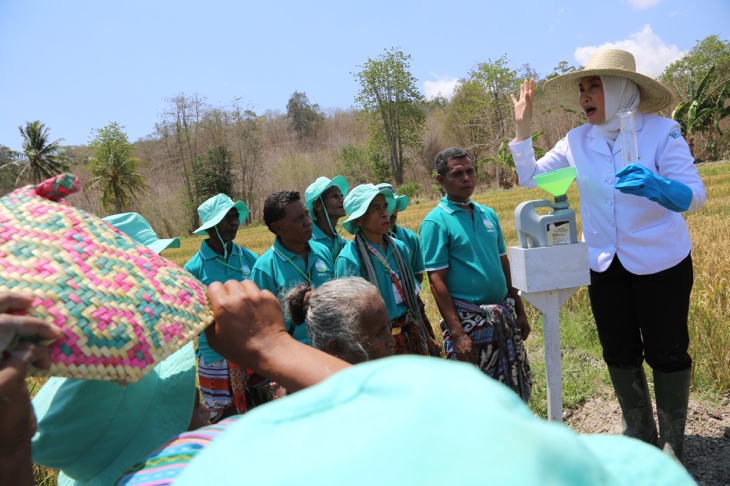[Prof. Dwikorita Karnawati, M.Sc. P.hD. – Head of BMKG]

At the commemoration of World Meteorological Day 70 on 23 March 2020, the theme “Climate And Water” was used as an international theme. Prof. Karnawati said that the theme had been with the world’s eyes on climate and water issues. According to Prof. Karnawati climate change is a long-term change from the statistical distribution of weather patterns over a period of time from decades to millions of years. It can be interpreted as an average change in weather conditions or changes in distribution of average weather events. Climate change can occur locally, confined to specific regions, or can occur throughout the Earth’s surface area. The change was marked at least by four things, first due to the global change/temperature rise, the two high rises in seawater, the three increasingly more extreme weather conditions and other, and the fourth is a change in rainfall patterns.
Climate change is currently marked by the increasing incidence of hydrometeorological disasters, including a reduced water availability and or even causing excess amount of water discharge at other times, as well as forest fires and land. These hydrometeorological disasters will potentially increase based on the projected future climate change, and can affect water resources, food, and energy resilience.
In Indonesia, from the historical data of rainfall in Jakarta for 130 years collected by BMKG identified by the trend of intensity and the frequency of extreme rain is increasingly high (Siswanto et al, 2016), correlated with flood events in Jabodetabek since the last 30 years (Siswanto et al, 2015 and Siswanto et al, 2017). The daily extreme rain intensity reached a new record 377 mm per day in the year 2020 was recorded at Halim Perdana Kusuma station (Siswanto et al, 2020). Climate change also affects the rise of air temperatures. Indonesia’s air temperature in the last 30 years rises about 0.1 degrees Celsius. The increase looks small, but the world has limited that until the year 2030 the temperature change should not be more than 1.5 degrees Celsius. Meanwhile, until the year 2020 this temperature increase in Indonesia has almost reached 1.6 degrees Celsius since 1866 (Siswanto et al, 2016). The scorched climate in Indonesia will also be accompanied by dry season that is getting dry up to 20 percent in some areas of Indonesia such as in South Sumatera, Java, Madura, Bali, West Nusa Tenggara and East Nusa Tenggara. In addition, the Community must be aware that Indonesia is located in the ring area of fire so disaster risk such as earthquakes, tsunami or volcano, mudslides to the flood is inevitable.
These challenges require early anticipation so that Indonesia and the world are able to adapt and mitigate appropriately. People can play a role in mitigation by doing small things but can reduce greenhouse gas emissions such as restricting the use of motor vehicles, starting to switch to public transportation, saving the use of electricity and water, reducing the use of plastic waste, and planting trees in the surrounding environment.

Figure 1. Prof. Karnawati when explaining to participants of the climate field school about the process of precipitation of rainfall (source: BMKG)
Further, this climate change does not perceive the boundaries of territorial and every country must feel it. Breakthrough and leap-based innovations to big data analytics and artificial intelligent are the necessity for increased mitigation and adaptation to climate change. Research conducted by experts need to focus on reducing carbon dioxide emissions to withstand the pace of global temperature rise. But it is also necessary to approach social innovation or social engineering as an effort to adapt to this climate change.
For example, farmers need to be equipped with knowledge to understand and utilize climate and weather information/predictions, to adjust the time, patterns and types of crops to be planted, in order to produce optimal food compounding products despite the various weather tension. By adapting this, farmers can also decide the planting time and the right harvest time, to avoid extreme weather/climate disturbances.
Up to now, the Non-Conventional Earth Resources Study Center (UGRG) has been trying to play an active role in research related to climate change, one of them through the study of CO2 concentration on ancient atmosphere and carbon accumulation rate based on succession of tropical peat for the reconstruction of ancient climate and related disaster mitigation due to Global warming (see related publications). In the future, UGRG is expected to develop appropriate related research for the safety and welfare of the people of Indonesia and the world.
Source:
- https://www.bmkg.go.id/press-release/?p=hari-meteorologi-dunia-ke-70-bmkg-mengajak-masyarakat-lebih-tanggap-pada-perubahan-iklim-dan-ketahanan-air&tag=press-release&lang=ID
- https://www.suara.com/news/2020/01/03/170643/bmkg-siklus-hujan-ekstrem-terjadi-lebih-cepat-akibat-perubahan-iklim
- https://news.harianjogja.com/read/2019/07/23/500/1007514/prediksi-bmkg-2030-suhu-di-indonesia-bakal-makin-panas
- Siswanto, G. J. van Oldenborgh, G. van der Schrier, R. Jilderda, B. van den Hurk, Temperature, extreme precipitation, and diurnal rainfall changes in the urbanized Jakarta city during the past 130 years, International Journal of Climatology 36 (2016) 3207 – 3225. http://dx.doi.org/10.1002/joc.4548.
- Siswanto, G. J. van Oldenborgh, G. van der Schrier, G. Lenderink, B. van den Hurk, Trends in high-daily precipitation events in Jakarta and the flooding of January 2014, Bulletin American Meteorological Society 96 (2015) S131 – S135.
- Student, G. van der Schrier, G. J. van Oldenborgh, B. van den Hurk, E. Aldrian, Y. Swarinoto, W. Sulistya, A. E. Sakya, A very unusual precipitation event associated with the 2015 floods in Jakarta: an analysis of the meteorological factors, Weather and Climate Extremes 16 (2017) 23 – 28.
- Siswanto, Andhika H., Yesi U. S., Tamima A., Marjuki, Trihadi E., Nasrullah, Herizal, Extreme Rainfall triggers Jakarta Floods in A Changing Climate Perspective, 2020 (in preparation for publication)
